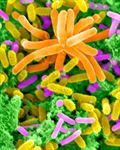
 Professor Mónica Medina started out as the only marine biologist in a National Science Foundation workshop last year, but she ended up with a group of new partners and an opinion piece in the prestigious journal Science that’s being released today.
Professor Mónica Medina started out as the only marine biologist in a National Science Foundation workshop last year, but she ended up with a group of new partners and an opinion piece in the prestigious journal Science that’s being released today.
Through discussions with colleagues from many other disciplines, including behavioral biologists and ecologists, she and others realized they had found something new together.
“We had fun, and we realized there’s an almost unexplored niche in science research – the connection between microbes and behaviors,” Medina said.
She and the article’s four other authors analyzed how much – or little – research has been done on the connection between the way animals behave and how the microbes that inhabit them affect such behaviors. They were glad to find out that Science magazine was interested in the topic and agreed to publish it as the “Perspectives” piece that’s out today.
“There are too few studies in this area,” said Medina, who’s with the School of Natural Sciences. “Microbiology and animal behavior research are two disciplines that have evolved separately. However, host-microbe interactions provide a new unexplored angle to look for ways to explain those behaviors.”
“Given that microorganisms represent one of the most prevalent forms of life on this planet, this creative kind of thinking can dramatically change our understanding of the biological world,” said UC Merced Vice Chancellor for Research Sam Traina.
 Until fairly recently, people thought of microbes associated with animals almost exclusively as harmful and pathogenic to their hosts. But all animals house microbes that are also beneficial, like the ones that live in intestines and help digest food. Some even seek them out, as humans do when we add supplements like probiotics to our diets.
Until fairly recently, people thought of microbes associated with animals almost exclusively as harmful and pathogenic to their hosts. But all animals house microbes that are also beneficial, like the ones that live in intestines and help digest food. Some even seek them out, as humans do when we add supplements like probiotics to our diets.
Associated microbial communities have already been shown to affect mating behavior in animals, so why not other behaviors?
Writing a manuscript and the paring it down for the “Perspectives” article also shaped some of Medina’s own research.
She and postdoctoral researcher Kristen Marhaver are now in the midst of an NSF-funded project looking at how microbes affect where coral larvae choose to settle.
“Once coral larvae choose a place to inhabit, they are there for life,” Medina said. “Where they settle will decide whether they live a few minutes, hours or days, or for hundreds of years, so it’s a very important choice. But how do they choose?”
Marhaver is in Curacao, an island in the Caribbean, performing the field work for their project. Other biologists look at the molecular mechanics of the coral larvae, while Marhaver is looking at the behaviors and what prompts them, hoping to illuminate the connection between the larvae and the microbes.
Someday, this work might be able to explain other types of behaviors, too.
For now, though, Medina and her colleagues from other universities just hope this open niche in research can be more fully addressed.
“We’re just presenting an opinion,” Medina said. “It’s a new perspective.”
Lorena Anderson

Senior Writer and Public Information Representative
Office: (209) 228-4406
Mobile: (209) 201-6255






